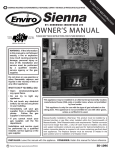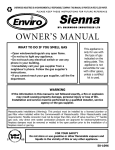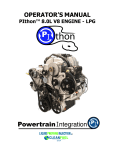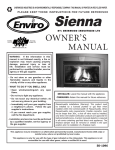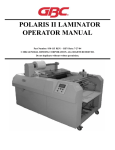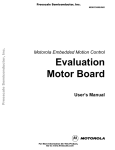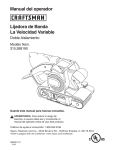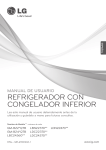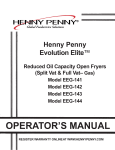Download GBC 3064WF User's Manual
Transcript
GBC 3064WF
Operation Manual
GBC 3064WF
INSTALLATION & OPERATING MANUAL
Part Number: 930-131, Rev A.
Part Number: 930-131.REV.10-17-05
© 2005 General Binding Corporation
ENG
Operating Instructions
F
Mode d'Emploi
E
Instrucciones de Operación
Page 1
GBC 3064WF
Operation Manual
ENG
The information in this publication is provided for reference and is believed to be accurate and complete. General Binding Corporation (GBC) is not liable for errors in
this publication or for incidental or consequential damage in connection with the furnishing or use of the information in this publication, including, but not limited to,
any implied warranty of fitness or merchantability for any particular use.
GBC reserves the right to make changes to this publication and to the products described in it without notice. All specifications and information concerning products
are subject to change without notice. Reference in this publication to information or products protected by copyright or patent does not convey any license under the
rights of GBC or others. GBC assumes no liability arising from infringements of patents or any other rights of third parties.
This publication is copyrighted © 2005 by GBC. All rights reserved. The information contained in this publication is proprietary and may not be reproduced, stored,
transmitted, or transferred, in whole or in part, in any form without the prior and express written permission of GBC.
F
L’information contenue dans cette publication est fournie à titre de référence et elle est considérée exacte et complète. General Binding Corporation (GBC) n’est pas
responsable des erreurs contenues dans cette publication ni des dommages indirects ou consécutifs portant sur l’utilisation ou la présentation de l’information de ce
document, y compris, mais sans s’y limiter, toute garantie implicite de commercialité ou d’adaptation à un usage particulier.
GBC se réserve le droit d’apporter des modifications à cette publication et aux produits qui y sont décrits sans préavis. Toutes les spécifications et l’information au sujet
des produits sont sujettes à changements sans préavis.
Toute référence à l’information ou aux produits protégés par un droit d’auteur ou un brevet présentée dans ce document ne porte aucune licence sous les droits de GBC
ou d’autres parties. GBC n’assume aucune responsabilité découlant de contraventions aux brevets ou à tout autre droit de tierces parties.
Cette publication est protégée par un droit d’auteur © 2003 de GBC. Tous droits réservés L’information contenue dans cette publication est privative et ne peut pas être
reproduite, mise en mémoire, transmise ou transférée, en partie ou en entier, sous quelque forme que ce soit sans la permission écrite préalable et expresse de GBC.
E
La información contenida en esta publicación es proporcionada a título de referencia y se considera que es precisa y completa. General Binding Corporation (GBC) no
es responsable por errores contenidos en esta publicación o por daños consecuentes o incidentales relacionados con la disponibilidad o el uso de la información en esta
publicación, incluyendo y sin limitarse a, cualquier garantía de aptitud y comerciabilidad para cualquier uso específico.
GBC se reserva el derecho de hacer cambios en esta publicación y a los productos descritos en la misma sin aviso previo. Todas las características y la información
referente a los productos, están sujetas a cambios sin aviso previo.
Las referencias en esta publicación a información o productos protegidos por derechos de propiedad intelectual o por patentes no otorga ninguna licencia amparada por
los derechos de GBC u otros. GBC no asume ninguna responsabilidad que se derive de la violación de patentes u otros derechos de terceras partes.
Copyright © 2003 Esta publicación está amparada por derechos de propiedad intelectual de GBC. Todos los derechos reservados. La información contenida en este
documento es de propiedad exclusiva y no puede reproducirse, almacenarse, transmitirse o transferirse, en su totalidad o en partes, y de ninguna manera, sin la
autorización previa y por escrito de GBC.
© 2005 General Binding Corporation
Page 2
GBC 3064WF
Operation Manual
ENG
TABLE OF CONTENTS
Description
Cover
Legal Disclaimer
Table of Contents
Important Safety Instructions
Important Safeguards
General
Electrical
Service
Warranty
Specifications
Pre- Installation
Installation
Control Guide
Power ON/OFF
Control Panel
LCD Display
Display Reset Switch
Display
Main Switch (TOP Heater)
Display
Main Switch (Bottom Heater)
Fan Switch
Main Roller (Up / Down)
Pull Roller (Up / Down)
Laminator main Control Switch
Machine Power On Light
Laminator Directional Motion
Control Switch
Laminator Speed Control
Features Guide
Emergency-Stop Buttons
Media Tray Table
Rewind Take up
Swing out Film Unwind Shaft
Unwind / Rewind Combo
Rewind Take Up
Removable Chill Idler
Upper Tension Idler
Lower Tension Idler
Pull Rollers
Heated Main Rollers
Table Idler
Main On / Off Switch
Swing around Control
Panel Arm
Control Panel Box
Electric Safety Beam
Nip Pressure Adjustment
Pull roll Lift handle
Main Roller Lift Handle
Pull Role Clutch Adjustment Knob
© 2005 General Binding Corporation
Page
No.
1
2
3
4
4
4
5
5
6
7
7
7
7
7
7
7
7
7
7
7
7
7
7
7
7
8
9
9
9
9
9
10
11
11
11
12
12
12
12
12
12
12
13
13
13
13
Description
Sequence of Operations
Page
No.
14
Operating Instructions
Film Loading and Threading
Load a Roll of Film
Webbing Thermal Film using
Threading Card
Webbing PSA Film / Mount Adhesive
Using Threading Card
Start Laminating
Method for Tacking new Film to
Existing Film
To Unweb The Laminator
Clearing a Film Jam (Wrap– Up)
15
15
15
Applications
Tips for Pre-Coating Boards
Tips for Mounting Pre-Coated Boards
Tips for Single Sided Lamination
Tips for Creating a Decal
Tips for Mounting a Decal
Thermal Encapsulation
AccuShield™
21
21
21
21
22
22
22
23
Speed/Temperature Control
24
The Art of Lamination
Basic Rules
Film Tension
Heat
Output
24
24
24
25
25
Maintenance
26
Trouble Shooting Guide
27
Service Agreement
27
16
17
18
19
19
20
Page 3
GBC 3064WF
Operation Manual
IMPORTANT SAFETY INSTRUCTIONS
YOUR SAFETY AS WELL AS THE SAFETY OF
OTHERS IS IMPORTANT TO GBC. IN THIS
INSTRUCTION MANUAL AND ON THE PRODUCT,
YOU WILL FIND IMPORTANT SAFETY MESSAGES
REGARDING THE PRODUCT. READ THESE
MESSAGES CAREFULLY. READ ALL OF THE
INSTRUCTIONS
AND
SAVE
THESE
INSTRUCTIONS FOR LATER USE.
THE SAFETY ALERT SYMBOL PRECEDES
EACH SAFETY MESSAGE IN THIS
INSTRUCTION MANUAL. THE SYMBOL
INDICATES A POTENTIAL PERSONAL
SAFETY HAZARD TO YOU OR OTHERS.
THE FOLLOWING WARNINGS ARE
FOUND UPON THIS PRODUCT.
ADVERTENCIA
Riesgo de choque
eléctrico
No abra:
Adentro no hay
piezas reparables
por el usuario.
Mantenimiento
solamente por
personal calificado
Attention
Avertissement
Risque de
Secousseélectrique.
Ne pas ouvrir.
Pas de pièces
réparables par
l'utilisateur.
Entretien
seulement par
personnel qualifié.
Electrical shock
hazard.
Do not open.
No user serviceable
parts inside.
Refer servicing to
qualified service
personnel.
THIS SAFETY MESSAGE MEANS THAT YOU
COULD BE SERIOUSLY HURT OR KILLED IF YOU
OPEN THE PRODUCT AND EXPOSE YOURSELF
TO HAZARDOUS VOLTAGE.
ADVERTENCIA
RODILLOS
CALIENTES.
PUNTO DE
PINCHAMIENTO.
Mantener manos y
ropa a distancia.
Attention
ROULEAUX
CHAUDS.
POINT DE
PINCEMENT.
Tenir mains et
vêtements à
l'écart.
Avertissement
HOT ROLLS.
PINCH POINT.
ADVERTENCIA
Mantener manos y
dedos a distancia.
Attention
LAME
COUPANTE.
Tenir mains et
doigts à l'écart.
WARNING: TO GUARD AGAINST INJURY
THE
FOLLOWING
SAFETY
PRECAUTIONS MUST BE OBSERVED IN
INSTALLATION AND USE OF THE
LAMINATOR.
General:
Keep hands, long hair, loose clothing, and articles such as
necklaces or ties away from the front of the heat and pull
rollers to avoid entanglement and entrapment.
The heat rollers can reach temperatures over 300oF (150oC).
Avoid contact with the heat rollers during operation or shortly
after power has been removed from the laminator.
Keep hands and fingers away from the path of the sharp film
cutter blade located at the film exit.
Do not use the laminator for other than its intended purpose.
Avoid moving the Laminator on uneven floor surfaces. Never
tilt the laminator.
Do not defeat or remove electrical and mechanical safety
equipment such as interlocks, shields and guards.
Do not insert objects unsuitable for laminating or expose the
equipment to liquids.
Electrical:
The Laminator should be connected only to a source of power
as indicated in these instructions and on the serial plate located
on the rear of the laminator. Contact an electrician should the
attachment plug provided with the Laminator not match the
receptacles at your location.
Keep hands and
clothing away.
THIS SAFETY MESSAGE MEANS THAT YOU
COULD BE BURNED AND YOUR FINGERS COULD
BE TRAPPED AND CRUSHED IN THE HOT
ROLLERS. CLOTHING, JEWELRY AND LONG
HAIR COULD BE CAUGHT IN THE ROLLERS AND
PULL YOU INTO THEM.
NAVAJA FILOSA.
IMPORTANT SAFEGUARDS
Avertissement
SHARP BLADE.
Keep hands and
clothing away.
THIS SAFETY MESSAGE MEANS THAT YOU
COULD CUT YOURSELF IF YOU ARE NOT
CAREFUL.
WARNING:
THIS
SAFETY
ALERT
SYMBOL PRECEDES EACH SAFETY
MESSAGE
IN
THIS
INSTRUCTION
MANUAL. THE SYMBOL INDICATES A
POTENTAL PERSONAL SAFETY HAZARD
TO YOU OR OTHERS.
WARNING: DO NOT ATTEMPT TO
SERVICE OR REPAIR THE 3064 WF
LAMINATOR.
WARNING: DO NOT CONNECT THE
LAMINATOR
TO
AN
ELECTRICAL
SUPPLY OR ATTEMPT TO OPERATE THE
LAMINATOR
UNTIL
YOU
HAVE
COMPLETELY
READ
THESE
INSTRUCTIONS.
MAINTAIN
THESE
INSTRUCTIONS IN A CONVENIENT
LOCATION FOR FUTURE REFERENCE.
© 2005 General Binding Corporation
WARNING: THE RECEPTACLE MUST BE
LOCATED NEAR THE EQUIPMENT AND
EASILY ACCESSIBLE.
Do not operate the Laminator with a damaged power supply
cord or attachment plug, upon occurrence of a malfunction, or
after the laminator has been damaged. Contact GBC’s
Technical Service Department or your dealer/distributor for
assistance.
Service:
Perform only the routine maintenance procedures referred to in
these instructions
WARNING: DO NOT ATTEMPT TO SERVICE
OR REPAIR THE LAMINATOR
Disconnect the plug from the receptacle and contact GBC’s
Technical Department or your dealer/distributor when one or
more of the following has occurred.
• The power supply cord or attachment plug is damaged.
• Liquid has been spilled into the laminator.
• The laminator is malfunctioning after being mishandled.
• The laminator does not operate as described in these
instructions.
Page 4
GBC 3064WF
Operation Manual
WARRANTY
Limited 90- Day Warranty
GBC warrants to the original purchaser for a period of ninety
days on labor and one year on parts after installation that this
laminator is free from defects in workmanship and material
under normal use and service. GBC’s obligation under this
limited warranty is limited to replacement or repair, at GBC’s
option, of any part found defective by GBC without charge for
material or labor.
THIS LIMITED WARRANTY IS IN LIEU OF ALL
OTHER WARRANTIES EXPRESSED OR IMPLIED.
WARRANTIES OF MERCHANTABILITY OR FITNESS
FOR A PARTICULAR PURPOSE ARE EXPRESSLY
EXCLUDED. ANY REPRESENTATIONS OR PROMISES
INCONSISTENT WITH, OR IN ADDITION TO, THIS
LIMITED WARRANTY ARE UNAUTHORIZED AND
SHALL NOT BE BINDING UPON GBC. IN NO EVENT
SHALL GBC BE LIABLE FOR ANY SPECIAL,
INCIDENTAL, OR CONSEQUENTIAL DAMAGES,
WHETHER OR NOT FORESEEABLE.
This limited warranty shall be void if the laminator has been
misused; mishandled; damaged by negligence, by accident,
during shipment, or due to exposure to extreme conditions;
repaired, altered, moved, or installed by anyone other than GBC
or its authorized agents; or if incompatible film was used.
GBC’s obligation under this limited warranty does not include
routine maintenance, cleaning, adjustment, normal cosmetic or
mechanical wear, or freight charges.
Without limiting the generality of the previous paragraph,
GBC’s obligation under this limited warranty does not include:
1. Damage caused to the rollers by knives, razors, or other
sharp tools: by any foreign objects falling into the working
area of the laminator; or by cleaning the laminator with
solutions or materials that harm its surfaces;
2. Damage caused by adhesives; nor
3. Damage caused by lifting, tilting or attempting to position
the laminator other than rolling it on its castors across even
surfaces.
FOR EUROPEAN UNION RESIDENTS ONLY: This
guarantee does not affect the legal rights which consumers have
under applicable national legislation governing the sale of
consumer goods.
SPECIFICATIONS
Operating Speed
Maximum Temperature
Maximum Mounting
Thickness
Maximum Film Width
Dimensions (W x D x H)
Weight
Electrical Requirements
Agency Approval
Voltage
Current
Power
Phase
FCC NOTE
Up to 20 fpm (5.5 mpm) MAX
300oF (149oC)
1 in. (25.4 mm) Max.
64 in. (162.5 cm)
Unit alone: (Uncrated)
86in. x 34.5in. x 57in.
(218cm x 88cm x 145cm.)
Depth of 3064 WF is 44 in (112 cm) with tables in up position.
Unit alone: 1500 lbs. (680 Kgs.).
Shipping: 1700 lbs. (771 Kgs.).
Refer to the serial plate located on the rear of the laminator for the specific electrical rating applicable
to the unit.
cULus
220 V, 60 Hz
32 A
7000 W
Single
FCC Class A Notice - Notification pour les Etats-Unis
Note: This equipment has been tested and found to comply with the limits for a Class A digital
device, pursuant to part 15 of the FCC rules. These limits are designed to provide reasonable
protection against harmful interference when the equipment is operated in a commercial environment.
This equipment generates, uses, and can radiated radio frequency energy and, if not installed and used
in accordance with the instruction manual, may cause harmful interference to radio communications.
Operation of this equipment in a residential area is likely to cause harmful interference in which case
the user will be required to correct the interference at his own expense.
Canada Class A Notice - Avis Canada, Classe A
This Class A digital apparatus complies with Canadian ICES-003.
Cet appareil numérique de la classe A est conforme à la norme NMB-003 du Canada.
Modifications
Any modifications made to this device that are not approved by General Binding Corporation may
void the authority granted to the user by the FCC and/or by Industry Canada to operate this
equipment.
Toutes modifications apportées à ce dispositif et non approuvées par General Binding Corporation
annuleront le droit accordé à l'utilisateur par le FCC et/ou par Industrie Canada de faire fonctionner
cet équipement.
© 2005 General Binding Corporation
Page 5
GBC 3064WF
Operation Manual
PRE-INSTALLATION
Before a 3064 Laminator can be installed, ensure the
following requirements are met:
1.
2.
3.
Are doorways and hallways wide enough for the
laminator to be moved to the installation site?
Is there ample room for the laminator?
• A work area must be established that allows for
operation in both the front and rear of the
laminator and provides space for efficient
material flow.
Is the environment appropriate for the laminator?
• The laminator requires a clean, dust and vapor
free environment to operate properly.
• Avoid locating the laminator near sources of heat
or cold. Avoid locating the laminator in the direct
path of forced, heated or cooled air.
CAUTION: Air flow can cause uneven heating /
cooling of the rollers and result in poor output
quality.
4.
Have you contacted a certified electrician to wire the
receptacle and ensure that adequate power is being
supplied, having the appropriate capacity, over
current protection and safety lockouts available?
GBC 3064 WF Requires:
• 220V at 60Hz with 32 amps single phase.
• Nema 6-50 R 50 A 250 V Receptacle
This Machine is supplied with a Nema 6-50 male
Plug
INSTALLATION
1.
2.
3.
4.
5.
6.
Note:
Shipping damage should be brought to the immediate attention of the delivering carrier.
With assistance, carefully roll the laminator into position over flat and even surfaces.
The laminator should be positioned to allow exiting film to flow freely to the floor or a work table. Accumulation of
laminate immediately behind the laminator as it exits the equipment may cause the film to wrap around the pull rollers,
resulting in a “jammed” condition.
Avoid locating the laminator near sources of heat or cold. Avoid locating the laminator in the direct path of forced,
heated or cooled air.
Once the laminator has been properly positioned, lock the castors in place. Locking the castors prevent the machine
from rolling during set up, operation or servicing.
Connect the attachment plug provided with the laminator to a suitably grounded outlet. Avoid connecting other
equipment to the same branch circuit to which the laminator is connected, as this may result in nuisance tripping of
circuit breakers or blowing fuses.
Machine must be leveled to ensure best performance. Level the machine by lowering both the main and pull rolls.
Lay A level on top of the main and pull rolls. Then, check level from main roll to pull roll on right and left side of the
roll. Finally, check by placing the level diagonally across lower main to lower pull rolls.
© 2005 General Binding Corporation
Page 6
GBC 3064WF
Operation Manual
CONTROL GUIDE
A. Power ON/OFF (I/O):
Located at the back left of the machine applies power to the
laminator. The control panel display will illuminate when
position marked “I” is pushed. The Off position, marked “O”
removes power from the laminator.
B. Control Panel (Figure 5)
1. Main Roll Nip Pressure relevant pressure in percentage:
2
a
1
3
4
b
8
5
6
9
1
7
2. Top Roll Display
• Displays Temperature in “oC “or “oF” of the Top Heater
(Both Set Temperature and Current Temperature)
• LED Marked “oC” if Illuminated indicates reading in “oC “
• LED Marked “oF” if Illuminated indicates Temperature reading
in “oF”
• LED Marked “Ready” illuminates when set temperature is
reached.
{a}. Control Switches:
⌃ - When Pressed Increases the Temperature
- When Pressed Decreases the Temperature
MEAS- Press and Hold to Display Current Top Roller
Temperature
3. Main Switch (TOP Heater): When pressed to the
Position turns On the top heater, when pressed to the
Position turns Off the top heater.
4. Bottom Roll Display
• Displays Temperature in “oC” or “oF” of the Bottom Heater
(Both set Temperature and Current Temperature when
MEAS switch is pressed)
• LED Marked “oC” if Illuminated indicates reading in “oC”
• LED Marked “°F” if Illuminated indicates Temperature reading
in “oF”
• LED Marked “Ready” illuminates when set temperature is
reached.
Figure 5
MEAS- Press and Hold to Display Current Bottom Roller
Temperature
{b}. Control Switches
∧ - When Pressed Increases the Temperature
∨ - When Pressed Decreases the Temperature
MEAS-Press and Hold to Display Current Bottom Roller
Temperature
5. Main Switch (Bottom Heater):
When pressed to the
position turns On the bottom heater, when pressed to the
position turns Off the bottom heater.
6. Fan Switch:
Switches cooling fan ON
7. Laminator Main Control Switch:
laminator between “RUN” and “STOP”
8. Machine Power On Light:
Machine On.
/ OFF
Switches the
modes.
Green light illuminated –
9. Laminator Direction Motion Control Switch: Controls the
forward and rearward movement of the laminator.
10. Laminator Speed Control:
Regulates the speed of laminator feed.
• Outer Scale in Feet/Minute.
© 2005 General Binding Corporation
Page 7
GBC 3064WF
Operation Manual
FEATURES GUIDE
Refer to the following pages for detailed information on the above Features
FEATURES GUIDE (DETAILED DESCRIPTION)
EMERGENCY STOP BUTTONS
(Fig. 1– Item A)
Four emergency stop buttons are available on
the Laminator on the top four corners of the
Laminator.
To engage Emergency -stop button, Press any
emergency -stop safety push button to stop
the roller movement
A
To disengage, turn the push button clockwise
after the emergency condition has been
resolved.
Figure 1
© 2005 General Binding Corporation
Page 8
GBC 3064WF
Operation Manual
A
B
C
Figure 2
B
Media Tables: (Fig. 2C & 3C)
On both the Front Media & Rear Media tables,
the safety interlock switch will not allow the
Laminator to operate at full speed unless the
tables are properly installed.
The Media tables are used to position items for
Lamination. There are two media tables on the
machine one on the front & one on the rear of
the Laminator. The Front Media table
incorporates an Idler on the leading edge of the
table. This is used for roll to roll applications
during lamination
Note:
The Laminator will operate only when the
Media Table and Media Table Latch are
Properly Installed.
The Accessories Include:
1.
A
2.
3.
C
Straight Slitter: Used for slitting the
media after lamination -- Rear Table.
(Fig. 3 – Item B)
Feed Guide: Used for guiding Media
through the laminator (Fig. 2B)
Pressure Plate: Used for guiding stock
and ensuring a wrinkle free feed into the
roller Nip. (Fig 2A)
Rewind Take up: (Fig. 3 – Item A)
This machine has one dedicated rewind film
take up positioned on the lower back of the
machine
Figure 3
Swing out Film Unwind Shaft: (Fig. 4C)
Swing out film unwind shaft is used to provide
tension to materials going into the lamination
roles. The unwind is located on the lower front
of laminator. (Fig. 4 – Item C)
The swing out unwind shaft brake knob varies
the tension. (Fig. 4E)
D
B
F
E
C
Unwind / Rewind Combo: (Fig. 4 & 5)
There are three unwind/rewind combo shafts,
Two Top Combo Unwind/Rewind shafts, one
on the top front and one on the top back of the
machine (Fig. 5A) and the third combo
unwind/rewind shaft is located below the front
table (Fig. 4B).
Unwind / rewind combo shafts can be used as a
standard swing out unwind for material supply
or be used as a rewind for liners and final
products.
The conversion from unwind to rewind just
requires the release of the upper brake adjust
knob (Fig. 4D) and tightening the rewind
adjustment knob. (Fig. 4F)
CAUTION: When using the combo unwind /
rewind shaft as a rewind, the upper brake
adjust knob (Fig. 4D) must be released to
limit the load on the motor, and wear & tear
on the machine.
The film shaft clutch is then engaged to the turn
with the motor to wind up film.
Figure 4
© 2005 General Binding Corporation
Page 9
GBC 3064WF
Operation Manual
A
Figure 5
Removable Chill Idler: (Fig. 6 – Item A)
A
The removable chill Idler is used to help smooth out
the laminating film during the cooling process.
Figure 6
© 2005 General Binding Corporation
Page 10
GBC 3064WF
Operation Manual
Upper Tension Idler: (Fig. 7 – Item A)
A
Upper tension Idler guides the laminating film
on to the main roll insuring a consistent amount
of wrap on the upper rolls.
Figure 7
Lower Tension Idler: (Fig. 8 - Item B)
B
Lower tension idler guides the lower lamination
film on to the lower roller.
Figure 8
Pull Rollers: (Fig. 9 - Item A)
A
The Pull rollers located at the back of the
laminator
are
motor
driven.
They
simultaneously pull the film and improve the
quality of the laminated item.
Figure 9
© 2005 General Binding Corporation
Page 11
GBC 3064WF
Operation Manual
Heated Main Rollers: (Fig. 10 – Item A)
A
B
Silicone rubber coated steel tubes heat the
laminating film and compresses the heated film
to the items being laminated. Heat is provided
by an internal heating element.
Table Idler: (Fig. 10 – Item B)
The Table Idler is used to assist in bringing the
material up to the nip.
The table Idler is helpful in roll to roll operation
and helps move large ridged panels through the
nip.
Figure 10
Main On
/
Off (I/O) Switch:
(Fig. 11 – Item A)
A
Located on the lower back of the control panel
side of the GBC3064WF is the main power
switch.
“I” means ON, ”O” means OFF.
Figure 11
Swing around control panel arm:
(Fig. 12 – Item A)
A
The Control panel is on a swing around arm
which will allow the operator to move the
necessary control to each side of the machine.
B
Control Panel: (Fig. 12 – Item B)
The Control panel has most of the machine
controls to operate the machine.
Figure 12
Electronic Safety Beam: (Fig. 13 – Item A)
A
Safety light beam is used to protect the Nip area
with out being, in the way of normal lamination
operation. Please see the following chart for
sequence of operations on Page 14.
Figure 13
© 2005 General Binding Corporation
Page 12
GBC 3064WF
Operation Manual
Nip Pressure Adjustment:
(Fig. 14 & 15 –Item A)
The Nip pressure adjustment allows the operator
to adjust the downward pressure of the pull rolls
and main rolls.
A
Pull Roll Lift handle:
Turn the handle clockwise to lower the upper
pull roll. (Fig. 14A)
Figure 14
Heated Main roll Lift handle:
Turn handle clockwise to lower main roll &
adjust the Nip Pressure (Fig. 15A)
A
Figure 15
Pull Roll Clutch Adjustment Knob:
The Pull Roll Clutch provides tension on the
laminated film between the main rolls and pull
rolls as the material is cooling. (Fig. 16A)
A
Figure 16
© 2005 General Binding Corporation
Page 13
GBC 3064WF
Operation Manual
SEQUENCE OF OPERATIONS
GBC U.S &CE 3064WF
Effect of Fiber Optics on sequence of operation
Modes
Situation 1
Situation 2
Situation 3
Machine Run Mode
Normal operation
(No Interruption to any
safety circuitry & Fiber
optic beam)High speed.
Interrupted fiber optic
beam or opened any
safety circuitry.
Fiber optic beam cleared + all safety
circuitries are closed
Control panel:
Forward Speed: Zero to
Max.
Press “RUN” push
button to switch over
from foot switch to the
control panel.
Machine stops Instantly.
Use foot pedal to override
@ 3f/m.
Machine will remain stationary until
run switch is pressed.
Push RUN button switch to run
machine again (Normal operation)
mode.
Foot switch:
Forward Speed: Zero to
Max.
Note: Press variable
foot pedal to change
mode and take over
from control panel at
preset speed.
Machine Runs @
3f/m.
(Automatic override from
high to low voltage)
Machine still remains at low voltage
speed of 3f/m.
Steps required to run at (various
speed): The operator will have two
choices,
Forward Mode
Press push button
forward switch
Choice A:
1. Release foot pedal to stop machine.
2. Press foot pedal again to start
machine at original preset control
panel knob speed (pot).
Choice B:
1. Press and hold “RUN” push button
switch on the control panel while foot
is still on pedal.
2. Release foot pedal.
3. Adjust speed using “speed knob”
Reverse Mode
Press Reverse
Push button switch.
Reverse speed: Zero to
Max.
Press “Run” push
button to switch over
from Foot switch to the
Control panel.
Machine stops Instantly.
Use Foot pedal to
override @ 3f/m.
Machine must not run. It will remain
stationary.
Push RUN button switch to run
machine again at Normal operation
mode.
Reverse speed: Zero to
Max.
Note: Press foot pedal
to change mode and
take over from control
panel.
Machine Runs @ 3f/m.
(Automatic override from
high to low voltage)
Machine still remains at low voltage
speed of 3f/m.
Steps required to run at (various
speed): The operator will have two
choices,
Choice A:
1. Release foot pedal to stop machine.
2. Press foot pedal again to start
machine at original preset control
panel knob speed (pot).
Choice B:
1. Press and hold “RUN” push button
switch on the control panel while foot
is still on pedal.
2. Release foot pedal.
3. Adjust speed using “speed knob”
© 2005 General Binding Corporation
Page 14
GBC 3064WF
Operation Manual
OPERATING INSTRUCTIONS
Film Loading & Threading
The top and bottom rolls of laminating film must be
of the same width and be present simultaneously. A
Small amount of adhesive will “squeeze out” during
Lamination. Hardened adhesive deposits can damage
the heat rollers.
CAUTION:
Adhesive will deposit on the rollers if:
• Only one roll is used.
n
ly-i
Po
• Different widths of rolls are loaded together.
e
siv
he
Ad rface
su
• Either roll is loaded adhesive side against a heat
roller.
A
Polyester surface
• One or both rolls of film are allowed to run
completely off its core.
The adhesive side of the film is on the inner side of
the web (Fig. 17A & B). The shiny side of clear film
must contact the heat rollers. The dull side of the
film contains the adhesive. Use extreme caution
when loading delustered (matte) film as both sides
appear dull.
Always change the top and bottom supply rolls at the
same time. Near the end of each roll of GBC
laminating film is a label stating “Warning-End of
Roll”. The appearance of this label on either the top
or bottom roll requires that new rolls of film be
installed as soon as the item presently being
laminated completely exits the rear of the laminator.
Do not introduce any additional items into the
laminator when the warning label is visible.
To load a roll of film: (Fig. 18)
1. Pull the swing out shaft clevis pin up.
2. Swing shaft outward.
3. Slide the roll of film onto the film shaft ensuring
Adhesive side is out.
4. Push the film shaft back into the film shaft
Support saddle.
5. Push the clevis pin down.
ut
ly-o
Po
e
siv
he
Ad rface
su
B
Polyester surface
Figure 17
1
4
5
2
6. Center the roll of film.
3
6
=
Figure 18
© 2005 General Binding Corporation
Page 15
GBC 3064WF
Operation Manual
Webbing Thermal Film Using Threading Card
THERMAL
LAMINATE
CAUTION: The laminator rollers will be hot and
can burn you.
1. Turn the Main Power ON
/OFF
to On.
2. Set top and bottom temperatures to the appropriate
setting for the film type used.
3. Ensure no brake tension is applied to the film shafts.
4. Pull the top roll film down under the upper idler bar
and allow to drape over the top heat roller (Fig. 19)
5. Pull the lower film behind the lower idler bar, Lower
the table, Pull Film up towards the film draped over
the top heat roller and adhere the lower film to the
upper Film (Fig. 20).
6. Pivot the table back to its feeding position while
ensuring the threading card is on top of the feed table
(Fig. 21).
7. Use a threading card to push the two materials into
the heat roller nip.
8. Lower the main roller to initial contact with the
threading card.
9. Ensure FRONT is selected for Motor direction and
Press the Foot Switch
10.From the rear of the machine, guide the web over the
chill idler, if installed, and through the pull rollers.
11.Once the web has entered the pull roller nip, lower
the pull roller. Adjust unwind film tension; use as
little tension as possible to get smooth output.
(See Page. 9)
12.Once the threading card has completely exited the
pull rollers, press the “STOP” ( ) button.
13.Now refer to the section titled “START
LAMINATING”.
Figure 19
THERMAL
LAMINATE
THERMAL
LAMINATE
Figure 20
Figure 21
© 2005 General Binding Corporation
Page 16
GBC 3064WF
Operation Manual
REWIND TUBE
Webbing PSA Film/Mount
Threading Card
Adhesive
Using
PSA
Film
The laminator should be cool to the touch before
Proceeding.
Mount
Adhesive
Figure 22
REWIND TUBE
PSA
Film
Mount
Adhesive
Figure 23
REWIND TUBE
PSA
Film
CHILLED ROLLER
1. Turn the Power ON
/OFF
to On
2. Load the rolls of film as illustrated in (Fig. 22).
Ensure no brake tension is applied to the film
shafts.
3. Pull the top roll of film down under the idler bar
and up to the upper front rewind tube.
4. Place one piece of masking tape in the center of
the film and secure to the rewind tube.
5. Make two full wraps around the rewind tube,
and then score the laminate without cutting the
release liner. Pull the laminate down allowing it
to drape over the upper roller (Fig. 22).
6. Pull the mount adhesive up towards the film
draped over the upper heat roller (Fig. 23).
7. Stick the mount adhesive to the exposed
adhesive of the upper roller.
8. Pivot the table back to its feeding position while
ensuring the threading card is on top of the feed
table (Fig. 24).
9. Use a threading card to push the two materials
through the heat roller nip
10. Lower the main heated roller to bring the main
roller into initial contact with the threading card.
Ensure front is selected and press the foot
switch.
11. From the rear of the machine, guide the web
over the chill idler, if installed, and through the
pull rollers. Once the web has entered the pull
roller nip, close the pull roller nip.
12. Press the “STOP” (
) button when the
threading card has completely exited the pull
rollers and adjusts the film web tension using as
little tension as possible.
13. Now refer to the section titled “START
LAMINATING”.
HEAT ROLLER
Mount
Adhesive
Figure 24
© 2005 General Binding Corporation
Page 17
GBC 3064WF
Operation Manual
Start Laminating
1. At this point you should have your laminator
Webbed with the appropriate material for your
application.
2. The feed table should be in the normal operating
position.
3. Close the main and Pull roll nips. Rollers should
be closed.
4. Speed is set to 3 or less and “FRONT” ( )
motor direction is selected.
5. Press the “START” ( ) button.
6. Set main roller pressure between 40% – 60% for
laminating by turning the main roll lift handle.
Figure 25
CAUTION: If using PSA film, an air pocket may
result between the main rollers and pull rollers.
Raise the pull rollers to allow the air Pocket to
pass.
7. Make any necessary film brake tension
adjustments, pull/main roller pressure, and
clutch and/ or rewind brake tension adjustments.
8. Position the item to be laminated on the feed
table.
9. Align the leading edge of the item parallel to the
heat roller nip (Fig. 25).
10.With both hands and an outward force push the
image slower than the speed of the rollers into
the nip of the heat rollers (Fig. 26).
CAUTION: Avoid forcing the image into the
main roller nip as this action will cause the
corners of the leading edge to buckle and create a
wave.
© 2005 General Binding Corporation
Figure 26
Page 18
GBC 3064WF
Operation Manual
Method for Tacking New Film to Existing Film
(1)
The following describes a method for loading film
whereby the existing film present on the heat
rollers may be used in place of the threading card
to draw the new film through the laminator. The
adhesive of the existing film must be tacky or
liquefied. Leading edges of the new film will be
overlapped onto the tacky adhesive of the old film.
The existing film and the new film will be pulled
through the laminator together.
(2)
(2)
CAUTION: Do not cut yourself
.......a PSA film or mount adhesive
A
CAUTION: Be careful not to cut any of the
rollers!
Figure 27
.......a PSA film or mount adhesive
Figure 27
© 2005 General Binding Corporation
B
1. Cut (1) remaining top film web between the
idler bar and heat roller. Cut (2) the film web
between the lower film supply and the idler
bar (Fig. 27).
2. Tilt the feed table down.
3. Do not allow the adhesive side of the film to
contact the heat or pull rollers. Liquefied or
tacky adhesive deposited on heat rollers will
require the rollers to be cleaned per the section
tilted “MAINTENANCE “.
4. Replace both the top and bottom rolls of film
with new rolls. Ensure the adhesive side is
facing out.
5. Pull the film around the idler bars, with the
exception of PSA mounting adhesives without
a release liner.
6. Tack the new film to the existing film on the
heat rollers. For PSA film, attach the release
liner to the rewind tube
7. Use the footswitch to advance the film into the
heat roller nip.
8. Observe the film being pulled through the
laminator to assure that the remaining existing
film and the new films are advancing
concurrently. Any separation between the
films will require stopping the motor
immediately and the situation corrected.
9. Press “STOP” ( ) once the newly threaded
film has completely exited the pull rollers.
Page 19
GBC 3064WF
Operation Manual
To unweb the laminator
Unweb the laminator if you are changing film
widths, cleaning the rollers or have finished using
the machine for the day.
(2)
(1)
CAUTION: Do not cut yourself
(3)
1. Using the rear slitter, cut (1) the output from the
web (Fig. 28).
2. Cut (2) remaining top film web between the
idler bar and heat roller. PSA film cut the
release liner too.
3. Cut (3) the film web between the lower film
supply and the idler bar (Fig. 28).
(2)
.......a PSA film or mount adhesive
Figure 28
CAUTION: Be careful not to cut any of the
rollers!
4. Tilt the feed table.
5. Gap the main rollers and pull rollers.
6. Carefully grab hold of the web (top and bottom
film), from the back operating position and pull
towards you (Fig. 29).
7. Do not allow the adhesive side of the film to
contact the heat or pull rollers.
PULL WEB
Clearing a Film Jam (Wrap-up)
Film jams (wrap-ups) may occur if the film is loaded
backwards or if the area at which film exits the
equipment is blocked. The film, when jammed,
wraps around the heat rollers or pulls rollers during
webbing if webbing, if a Threading Card is not used.
Figure 29
To clear a jam:
1. Immediately stop the laminator by pressing
“STOP” ( ).
2. Set motor direction to “REAR” ( ).
3. Use the footswitch to reverse the web until the
wrap up is clear.
4. Raise the main roller and pull rollers.
5. Manually guide the web from the main rollers
and pull rollers.
6. Once the film jam has been cleared, lower the
main roller and pull rollers.
7. Refer to the section titled “START
LAMINATING”.
© 2005 General Binding Corporation
Page 20
GBC 3064WF
Operation Manual
APPLICATIONS
Tips for Pre Coating Boards
MOUNT
ADHESIVE
LEADER BOARD
TRAILOR BOARD
BOARDS
Figure 30
1. Load the laminator as illustrated in (Fig. 30).
Remove chill idler.
2. The width of the roll should not exceed the
width of the board by more than 1/2 in. (1.3
cm).
3. Use a leader board to set the main roller and
pull roller pressure prior to webbing.
4. Use a leader board to start the run and a trailer
board to finish the run.
5. Using the pull rollers will allow you to leave
gaps between boards.
6. If not using the pull rollers, have the boards
nearby to butt end to end during feeding.
Tips for Mounting Pre Coated Boards
1. Use a leader board to set the main roller
pressure prior to mounting the image.
2. Ensure the chill idler is removed and the rear
slitter is to one side.
3. Do not stop once you have started the mounting
process through the machine. (Fig. 31)
IMAGE
RELEASE LINER
PRE-COATED BOARD
Note: This application can also be performed from
the rear operating position. Reference Fig. 34 for
Illustration.
Tips for Single Sided lamination
Figure 31
MOUNT
ADHESIVE
RELEASE LINER FROM PSA FILM
OUTPUT
IMAGE
ROLL TO ROLL OPTION
KRAFT
PAPER
OPTION
1. Load the laminator as illustrated in Fig. 32.
2. Use kraft paper for one-sided lamination When
ever the items to be laminated are narrower than
the film you are using.
3. If not using kraft paper, use a scrap piece to
finish the run or you will have adhesive on your
rollers.
4. For high volume runs, use Kraft paper and the
lower rear rewind for roll to roll operation.
5. Running the web over the chill idler may
improve the Flatness of the output.
6. A little heat 125oF (52oC) may help eliminate
silvering effects associated with PSA films.
Figure 32
© 2005 General Binding Corporation
Page 21
GBC 3064WF
Operation Manual
Tips for Creating a Decal
1. Load the laminator as illustrated in Fig. 33.
2. The over laminate may be PSA or thermal type.
3. If using thermal type, pay attention to the Polyin/Poly-out rule.
4. Run a test material prior to running the actual
image to ensure flat output.
5. Use minimal brake tension to achieve quality
output.
6. Do not web the PSA mount adhesive around the
lower web idler.
THERMAL
OR PSA
FILM
RELEASE LINER FROMPSA FILM
OUTPUT
IMAGE
MOUNT
ADHESIVE
ROLL TO ROLL OPTION
Tips for mounting a Decal
Figure 33
1. Use a leader board to set the pull roller pressure
Prior to mounting the image.
2. The image should not exceed the width of the
board by more than 1 in. (2.54 cm) per side.
3. Tack about 1 in. (2.54 cm) of the leading edge
of the image to the leading edge of the board.
4. When tacking the leading edge, start in the
center and work to the sides.
5. Use a board that exceeds the size of the decal if
inexperienced in the mounting application.
IMAGE
RELEASE LINER
BOARD
Note: This application can also be performed from
the front operating position. Reference Fig. 31 for
Illustration.
Figure 34
Tips For Thermal Encapsulation
1. Load the laminator as illustrated in Fig. 35
Poly-in film is used for illustration purpose.
2. Refer to section titled “FILM LOADING &
THREADING” for Poly-out film.
3. Always use two rolls of film the same width.
4. Use minimal brake tension to achieve flat
output.
5. Increase speed gradually to maintain the
activating temperature required for the laminate
you are using.
6. Length and width of image, ink coverage and
paper type may affect the temperature and speed
recommended in the SPEED/ TEMPERATURE
GUIDE.
© 2005 General Binding Corporation
THERMAL
FILM
IMAGE
OUTPUT
ROLL TO ROLL OPTION
THERMAL
FILM
Figure 35
Page 22
GBC 3064WF
Operation Manual
REWIND
THERMAL
FILM
Tips for ACCUSHIELD
IMAGE
OPTIONAL
SEPERATOR BAR
OUTPUT
ROLL TO ROLL OPTION
1. Load the laminator as illustrated in Fig. 36.
2. You must have the Separator bar option to
accurately run this material.
3. Set Top Temp to 265oF (129oC) and a speed
setting no greater than 4.
4. Liner rewind tension will be greater than normal
operating standard
5. To prevent some adhesive adhering to the rollers,
you may choose to use a roll of craft paper for a
Carrier.
KRAFT
PAPER
OPTION
Use the blank space below and blank diagrams to
Note your tips and web paths for your Special
applications.
Figure 36
TIPS FOR CUSTOM APPLICATION #1 (Fig. 37)
1.
2.
3.
4.
CUSTOM WEB PATH #1
Figure 37
TIPS FOR CUSTOM APPLICATION #2 (Fig. 38)
1.
2.
3.
4.
5.
CUSTOM WEB PATH #2
Figure 38
© 2005 General Binding Corporation
Page 23
GBC 3064WF
Operation Manual
SPEED / TEMPERATURE CONTROL
This is only a general reference guide. Different settings may be suitable as the warm up time, lamination time and materials
change.
Factors that may affect the speed and temperature parameters;
1.
2.
3.
4.
5.
6.
7.
8.
9.
Image length
Image width and ink coverage.
Ink coverage
Paper type
Laminate thickness
Operating environment
Condition of the rollers
Line voltage (effects heaters)
Using cooling features.
You may have to adjust temperature or speed depending on stock finish, thickness *Turn heat off when not in use.
THE ART OF LAMINATION
BASIC RULES
•
Do not attempt to laminate abrasive or metal Objects such as staples, paper clips and glitter, as they may damage the
heat or pull rollers.
•
Do not force items into the nip area of the heat rollers. An item that is not easily drawn into the laminator by the heat
rollers is probably too thick to laminate.
•
Wrinkles may result if an attempt is made to reposition an item once it has been grasped by the heat rollers.
•
Do not stop the laminator before an item has completely exited the pull rollers. Even a momentary stop will cause a
mark (heat line) on the laminated item.
Good, consistent lamination is a result of combining proper heat, tension and dwell time. Dwell time is controlled by the speed of
the motor and is defined as the amount of time the material to be laminated is compressed between the heat rollers.
As a general rule, thicker items and film need to run at slower speeds because they extract more heat from the rollers at a quicker
rate. Setting the speed control at slower settings gives the laminator longer dwell time thus allowing proper lamination of thick
items. Thinner items, such as standard copier paper (20 lb. bond) and tissue paper, extract less heat from the rollers and can be run
at faster speeds.
FILM TENSION
Proper film tension, known as brake tension, is the minimum amount required to eliminate wrinkles in the finished item. The film
should be taut. A properly adjusted roll of film should not require excessive force to turn by hand.
Film tension should be enough to introduce a minor amount of drag as the film unrolls. Insufficient tension causes wrinkles, while
too much tension causes stretching (necking). Uneven tension between the top and bottom rolls creates curl. Too much upper
tension creates upward curl while too much bottom tension causes downward curl.
Adjustment of the pull roller clutch may be necessary if after adjusting unwind and rewind brake tensions do not improve your
output quality.
© 2005 General Binding Corporation
Page 24
GBC 3064WF
Operation Manual
Heat
-A-
-B-
Figure 39
The “READY” indicator may extinguish if the speed
is set too fast for the material being laminated. Either
lower the speed setting or press “STOP” ( ) and
wait until the “READY” indicator illuminates.
Operation of the laminator for more than thirty
minutes at a time may necessitate a lower speed
setting. It is recommended that, during periods of
long runs, the items being laminated are alternated
between thick and thin. Do not combine thick and
thin items at the same time, as this will result in a
poor edge seal around the thinner material. If you are
unsure that the laminator is set at the proper speed
for the item to be laminated, run a test piece (scrap)
of the same or similar material through the
Laminator. This procedure is recommended because
rotating the heat roller prior to lamination will more
evenly distribute the heat.
Make speed adjustments if necessary.
Output
1. “D” waves in the image (Fig. 39 A).
• Check paper tension.
• Paper may be damp or not dry.
2. “D” waves in the laminate (Fig. 39 B).
• Check main roller pressure.
-A-
-B-
Figure 40
• Check pull roller pressure.
3. Straight waves in output (Fig. 40 A).
• Check operational settings for materials
being used.
• Check clutch tension.
4. Indent waves in output after pull rollers
• Insufficient cooling time.
• Output was handled prior to cooling.
• Use cooling feature if not on.
• Machine was stopped on print.
5. Angled waves in the output
• Main air Supply setting
• Check main Roller Pressure.
• Check main roller pressure.
-A-
-B-
Figure 41
© 2005 General Binding Corporation
• Check pull roller pressure.
• Check for Paper Tension.
Page 25
GBC 3064WF
Operation Manual
MAINTENANCE
Caring For The GBC 3064WF Laminator
GBC offers Cleaning kits as well as Extended Maintenance Agreements.
Contact your local GBC Service Representative or your dealer/distributor for additional information. The only maintenance required by the
operator is to periodically clean the heat rollers and schedule semi annual maintenance checks. The following procedure will help keep the heat
rollers free of adhesive that has been deposited along the edge of the laminating film. Proper alignment of the rolls of film reduces the amount of
“squeeze out”.
WARNING:
Do not attempt to laminate adhesives marked “Flammable”.
Do not laminate glitter and/ or metallic items. Damage to the rollers may result.
WARNING:
Do not apply any cleaning fluids or solvents to the rollers. Some solvents and fluids could ignite on heated
rollers.
Never clean rollers with sharp or pointed objects.
Hardened adhesive deposits on the rollers can cause damage to the rollers. Rotate the rollers at the lowest speed
setting on the control panel.
CAUTION:
1.
THE FOLLOWING PROCEDURE IS PERFORMED WHILE THE LAMINATOR IS HOT. USE EXTREME
CAUTION.
Remove the film from the laminator following the Procedure outlined in steps 1 through 6 of the section entitled TO UNWEB THE
LAMINATOR.
2.
Preheat the laminator until the “READY” indicator Illuminates.
3.
Tilt the feed table.
4.
Rub the top and bottom heat rollers with a 3M™ Scotch-Brite™ pad . DO NOT USE METAL SCOURING PADS!
5.
Use the footswitch to rotate the lower heat/ pull roller to an unclean portion. The upper heat/ pull rollers are free spinning. Continue this
process until the complete surfaces of both rollers are clean.
6.
Refer to the beginning of the section titled “OPERATING INSTRUCTIONS” to web your laminator.
NOTE:
Do not use metal scouring pads to clean the rollers.
© 2005 General Binding Corporation
Page 26
GBC 3064WF
Operation Manual
TROUBLE SHOOTING GUIDE
SYMPTOM
POSSIBLE CAUSE
The control panel display does not
illuminate when POWER ON/OFF
is in the ON, marked “I”, position.
Heat rollers do not turn when
POWER ON/OFF is in the ON,
marked “I”, position.
Press the “RUN” ( ) button and the
motor does not turn.
Heat rollers only turn if I use the
“Footswitch”.
Laminated items exhibit curling.
Laminator not connected to electrical
supply
Blown out fuse.
Feed table not properly installed.
Insert attachment plug into
receptacle
Check fuses.
Tilt feed table and properly replace
it.
E-Stop button activated
Adhesive deposited on heat rollers.
Top and bottom film webs not
aligned
Laminate improperly loaded.
Pull out on the E-STOP turn
clockwise.
Disengage the footswitch mode.
Clear nip area.
Adjust tension per section FILM
TENSION.
Adjust tension per section FILM
TENSION.
Make sure bottom roll of film is
around idler bar and that is the
normal operation position.
Release heat and pull roller pressure,
align the rolls of film.
Adhesive (matte) side of laminate
film may be against the heat rollers.
Unweb and reload the film properly.
Lower speed setting.
Photo eye is blocked.
Tension between the top and bottom
film. Roll is unequal.
Tension on top or bottom roll of film
is too film is too loose.
Bottom film roll may be improperly
loaded.
Speed setting too fast for type of
material being laminated
Insufficient heat
Laminate improperly loaded
Heat rollers require cleaning.
Laminated item unsuitable for
adhesion.
CORRECTIVE ACTION
Wait for “READY” indicator to
appear in the control panel display.
Adhesive side of film must be facing
away from the heat rollers.
Bottom roll of film not threaded
behind the idle bar.
Clean heat rollers per procedure in
section CARING FOR THE GBC
3064 WF LAMINATOR. Item may
be dirty or may have non porous
surface that is extremely difficult to
laminate.
SERVICE AGREEMENT
GBC’s Equipment Maintenance Agreement will insure the quality performance and long life built into your laminator.
A service charge for travel time, labor and parts may be incurred for each out of warranty service call. GBC’s Equipment Maintenance Agreement
decreases these expenses and protects your valuable investment. GBC offers several types of agreements to suit your needs and budget. To contact
GBC write to:
GBC NATIONAL SERVICE
IN CANADA:
GBC NATIONAL SERVICE
ONE GBC PLAZA
49 RAILSIDE ROAD
NORTHBROOK, IL 60062 U.S.A.
DON MILLS, ONTARIO
M3A 1B3
General Binding Corporation
One GBC Plaza
Northbrook, IL 60062-4195
®
© 2005 General Binding Corporation
Page 27






























